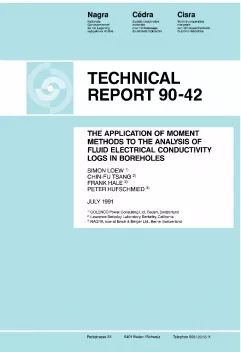
Technical Report NTB 90-42
The application of moment methods to the analysis of fluid electrical conductivity logs in boretoles
The present report describes new methods for the quantitative analysis of dynamic fluid electrical conductivity logs measured in boreholes under production or free outflow conditions. The methods form powerful complements and extensions to a testing procedure and best-fit simulation approach previously presented by Tsang et al. (1990). The testing and analysis procedures allow an exact location of all fractures flowing under the given head drawdown and intersected by the borehole (± 1 m in deep boreholes), as well as the calculation of the transmissivity (and head) of the individual flowing fractures.
The three methodologies presented in the present report start from the Classical Moment approach applied to the 1D advection-diffusion equation, which is then further developed to allow for the quantitative analysis of multiple interfering fracture outflows into the borehole.
After a general discussion of the testing procedure and the governing equation used for analysis (Section 1), the zero'th and first moment relationships of a single fracture outflow into a borehole during pumping are derived and related to the volumetric well bore flow rates below and above an outflow zone (Section 2). These parameters can be used directly to evaluate the volumetric flow rate and the fluid electrolyte concentration of all non-interfering fracture outflows.
Sections 3 and 4 present new approaches for the analysis of interfering peaks. The Partial Moment Method (Section 3) is based on integral quantities with a similar structure as the classical moments, but measured between fracture outflows and not across. The assumption made in the development of the fundamental equations is that of 1D advective-dispersive electrolyte transport along the borehole with constant velocity, v, and dispersion, k, within the short intervals between fractures. The method allows, on principle, for an independent determination of v and k within any interval of the logged section and for any time, t, during logging. This implies that the method can also be used when both the fracture fluid concentration and the fracture flow rate are changing with time. The major limitation of the Partial Moment Method is related to numerical instabilities at late logging times.
The Direct Integral Method (Section 4) is based on a mass balance approximation taking into account early time zero'th moment information and avoids the integral derivatives with their potential instabilities. The electrolyte transport is simplified with respect to the governing equation outlined above in the sense that only advective transport is considered at locations where the wellbore velocity is estimated.
In Section 5 the three methods are applied to synthetic test cases generated with a 1D advective-dispersive transport simulator (BORE). Two different types of test cases, with parameters similar to the field data measured in the Leuggern deep well of northern Switzerland, are considered: Test Case I with widely separated and only weakly interfering outflow peaks, Test Case II with closely spaced and strongly interfering fracture outflows. The application shows the different sensitivities of the analytical methods considered. The methods are ab1 e to reproduce the input with an error smaller than 50 % and for certain cases down to a difference of 1 or 2 %. It is shown that for the given parameters early time data give much more important information than late time data and that test duration can be reduced significantly (to 50 or 100 hours of logging, compared to 600 hours in the case of Leuggern) without losing relevant information.
In Section 6 the three methods are applied to real field data from the Leuggern deep borehole, measured in 1987. Besides precise localization of all flowing fractures intersected by the borehole, it can be shown that the Classical Moment Method and the Direct Integral Method form a valuable input and starting base for simulation and refinement with a simulator like BORE. By comparison with independently derived fracture flow rates from packer testing performed extensively in the Leuggern borehole, it can be shown that the Partial Moment Method is capable of reproducing the packer test results within a factor of 2 or 3 (greatest difference smaller than half an order of magnitude). These ranges lay within what is generally recognized as the uncertainty in packer testing.
Section 7 describes the implications for field experiment design and data analysis. The field experiment design should account for the needs of the analytical methods outlined. With respect to data analysis a comprehensive analysis procedure that takes into account conceptual uncertainty, data quality, and type of conductivity logging data (early or late time) is developed.
